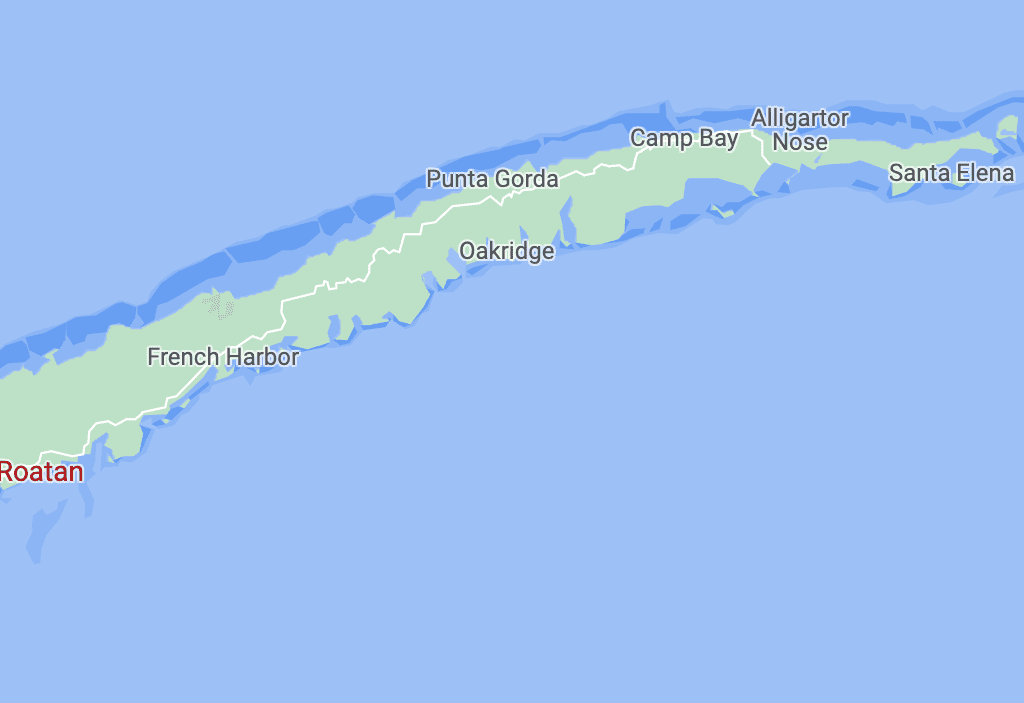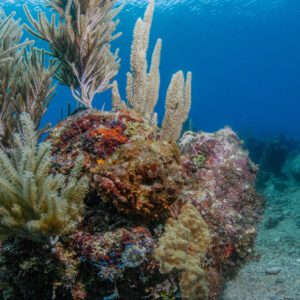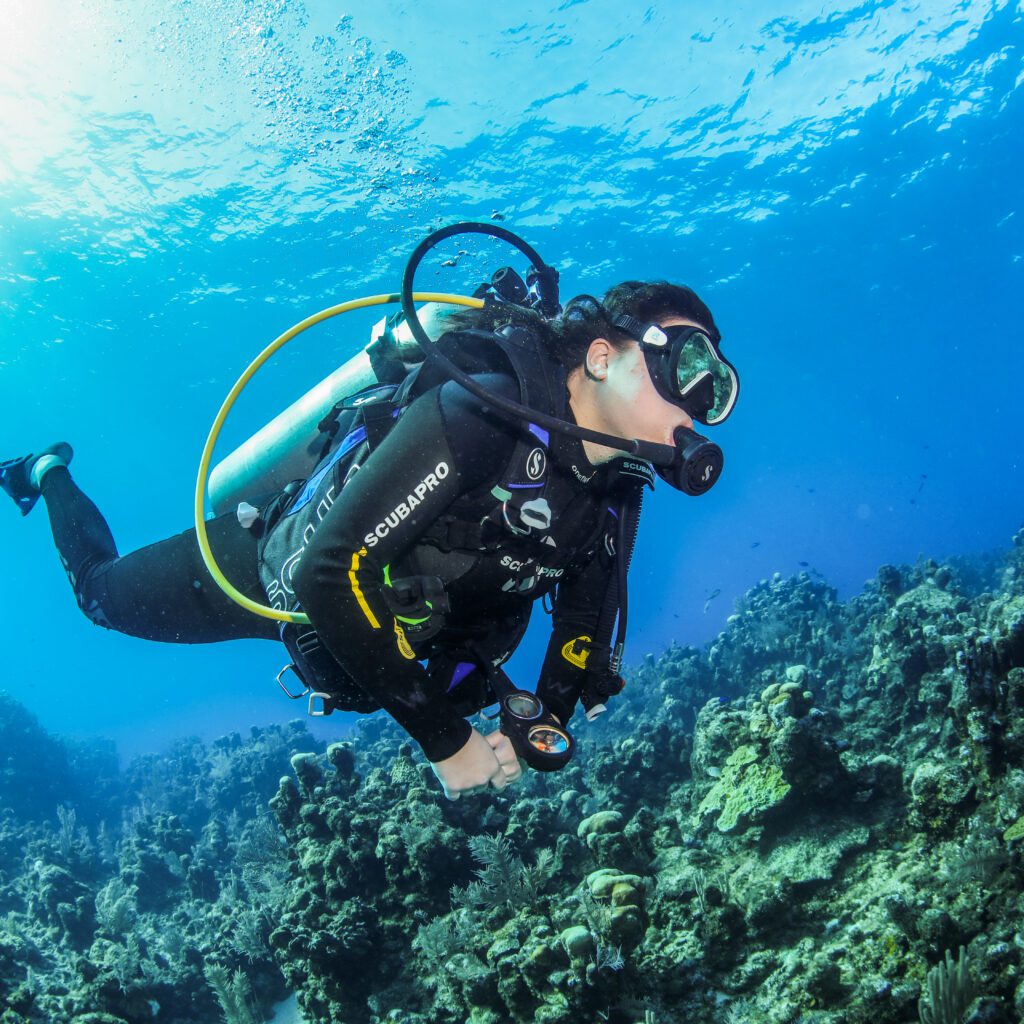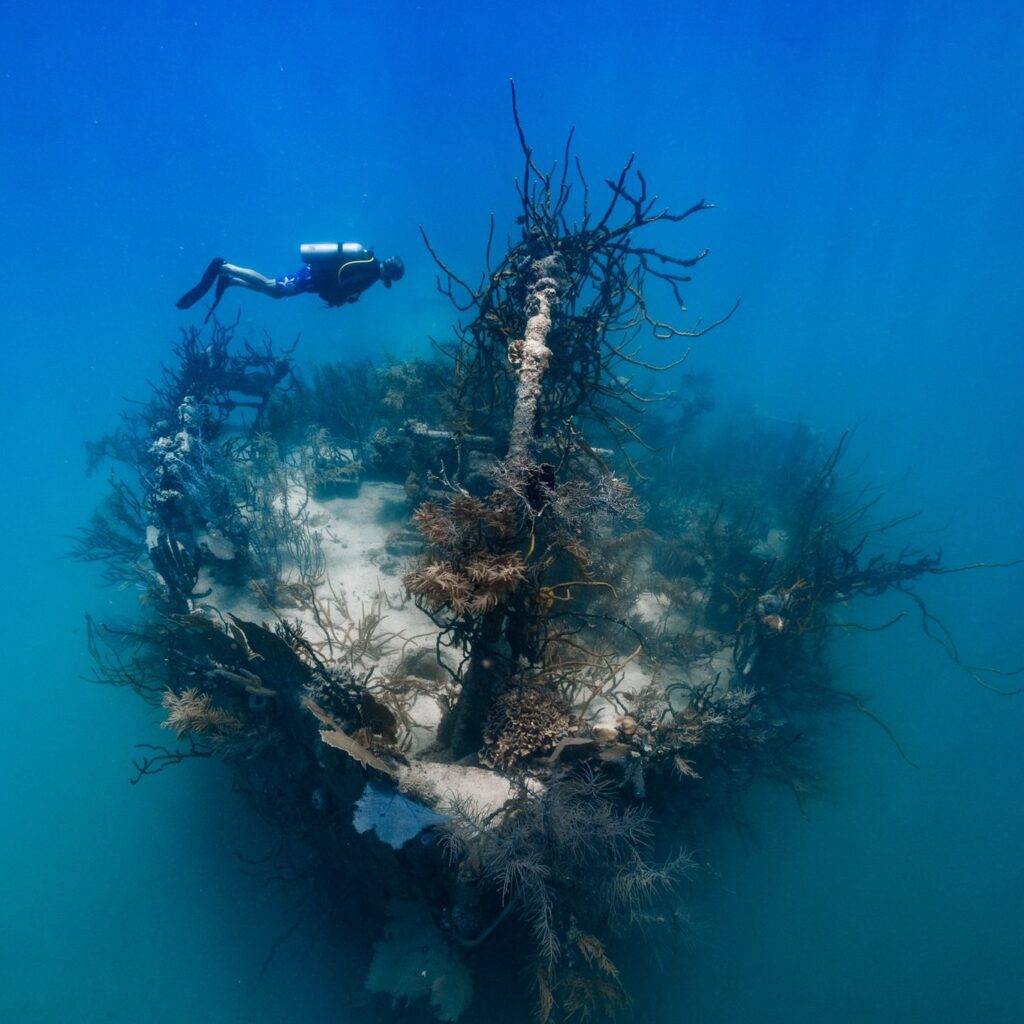Topic: Roatan Dive Sites
Do You Need a Wetsuit to Dive in Roatan?
Roatan is a Caribbean paradise known for its scenic and beautiful reefs. Its warm tropical waters attract a diversity of marine life and many divers each year. But are Roatan’s waters so warm that you don’t need a wetsuit to dive in Roatan?
Generally, yes, most people need a wetsuit to dive in Roatan. But depending upon the year and personal preference, the type of exposure suit you need can vary from full 3mm to even just a rashguard.
Let’s explore the 5 factors that can help you decide if you need a wetsuit to dive in Roatan and what type of wetsuit is best for you:
1. Water temperature
While Roatan enjoys cozy tropical waters throughout the year, the temperature can vary slightly depending on the season. The average water temperature ranges from 80°F (25°C) to 84°F (29°C). The water tends to be warmer during the summer months from May to September. The temperature slightly drops during the winter months from October to April. If you’re on the “get-cold easy” side or plan to do multiple dives a day, a wetsuit can provide added comfort and insulation.
Most divers choose to wear a 2.5mm shorty or even just a rash guard and leggings during the summer months. And then a full 3mm wetsuit during the winter months. People who get colder might also opt to add an extra layer of protection with a hooded vest under their wetsuit to dive in Roatan. Then there are those who seem to run hot year-round and opt for just a shorty or rash guard any time of year. This gives them ultimate freedom and mobility – but isn’t for the faint of heart!
If you want to find out more about the weather in Roatan throughout the year, read our post on: When is the best time to dive in Roatan?
2. Dive duration
The longer you’re in the water, the colder you might get. For short dives in shallow water, you’ll maybe be comfortable enough without a wetsuit. But for longer dives a wetsuit can help regulate your body temperature and protect you from potential heat loss. It’s really annoying to not enjoy your dive because you’re too cold. You might also get cold, when you’re doing multiple dives a day. At Sun Divers, all fun dives are at least 60 minutes. Consider how long your dives and surface intervals will be for your decision on if you need a wetsuit to dive in Roatan or not.
3. Dive depth
Another factor to consider when deciding whether you want to wear a wetsuit to dive in Roatan is your dive depth. As you descend into deeper waters, the temperature drops. In Roatan, the water temperature starts to cool when you descend beyond approximately 30 to 40 ft (9 to 12 m). You might feel the temperature drop a bit, especially if you spend an extended amount of time down there. If you’re into deep dives, Roatan has a few interesting dives that you might want to check out such as Hole in the Wall and our wrecks, The Aguila and Odyssey. It is important to note that the exact temperature variation can vary depending on factors such as the season and current as well.
In order to dive below 60 ft (18m) you need to be Advanced Open Water certified or do it as an Adventure Dive. You can find out about the benefits to get Advanced Open Water certified in our blog post.
4. Personal comfort
Every diver has their own preferences and comfort levels when it comes to ideal water temperatures. Some divers may feel comfortable diving without a wetsuit in Roatan’s warm waters. Others may prefer the added comfort, protection and warmth that a wetsuit provides. Ultimately, it is a personal choice based on your individual comfort and needs. Regardless of your decision, we always recommend wearing a rash guard or mineral-based sunscreen to protect your skin from the sun’s rays. If you do wear sunscreen please avoid petro-chemical sunscreens.
You can find out more about reef safe sunscreen.
5. Protection
Besides temperature regulation, wetsuits also offer additional benefits such as protection against the sun’s harmful rays or jellyfish stings. Diving in tropical environments closer to the equator means being exposed to intense sunlight, and wearing a wetsuit can provide a layer of UV protection for your skin. Luckily, we don’t see many jellyfish in Roatán. But occasionally, they hang out at the surface during night dives. If there is any, a wetsuit will protect you from being stung.
Gloves are not allowed
Did you know that in the Roatan Marine Park, the use of gloves during diving is not permitted? There are good reasons for this regulation. The main purpose of the Roatan Marine Park is to protect and preserve the delicate marine ecosystem of this incredible reef. This includes the corals and other marine life. Gloves can unintentionally cause damage. The texture of gloves can damage corals and other fragile organisms when touched. Gloves may also give divers a false sense of security. This can lead to careless contact with delicate structures. Eco friendly and sustainable diving practices are a top priority at Sun Divers. By respecting the “no gloves” policy, we can contribute to the conservation efforts of the marine park and ensure that no one is “touching, taking or teasing” the wildlife.
We’ll help you choose
At Sun Divers, we understand that divers have different preferences when it comes to thermal protection and sun exposure. Our experienced staff will guide you and give you recommendations based on current water conditions, your individual preferences, and the dive site characteristics. We offer a variety of different style and thickness wetsuits to rent from including 3mm full wetsuits, shorties and a variety of rash guards.
If you prefer to purchase your own wetsuit we are a certified Scubapro dealer and we offer deals, as well as direct shipping to Sun Divers customers.
Whether you choose to dive with a wetsuit, a rash guard, or without any additional protection at all, discover the beauty of our underwater world and embark on unforgettable diving adventures in Roatán with Sun Divers. We prioritize safety, small group diving and epic adventures.
So, do you need a wetsuit to dive in Roatán? The choice is yours, and we’re here to support you every step of the way as you explore the wonders beneath the surface of the Caribbean Sea. Contact us for more information.
‘Southside Days’ bring year-round diving in Roatan
Whether you are traveling to Roatan for the first time or are a regular visitor, you can always assume the tropical weather will throw some curveballs during your vacation. That’s just the small price we pay to enjoy the pristine beauty of a remote island in the Caribbean.
People often ask, “will rain effect our dive trip?” Or they see high winds and high seas in the forecast and automatically assume the weather is going to prevent them from diving.
Will Weather Affect My Diving in Roatan?
The short answer is “No.” And this answer is right about 99% of the time. The long answer is this:
There are always exceptions, but with “rainy season” actually comes unique diving opportunities when you’re diving in Roatan. Before looking into those specifics, let us take a step back and explore how the weather impacts the island.
Wind Matters Most
Roatan is shaped a bit like a sideways banana, running 48 miles long / 77km from southwest to northeast. What direction winds are traveling in, their strength and how they hit the contour of the island are the biggest variable in perfect dive conditions on Roatan.

For the majority of the year, trade winds cross the island from east to west. This makes the Eastern and Southern side of the island very rough. Conversely, the mountainous island impedes the wind resulting in flat calm seas on the Western edge and Northside of the island.
Fortunately, Sun Divers is perfectly situated on the western coast of the island on one of the Caribbean’s most idyllic spots on the beach in Half Moon Bay. The low wind and calm seas create the perfect conditions for diving in crystal clear water.
However, during the rare days when the wind shifts directions and makes western Roatan rough, there is a major silver lining: The Southside becomes calm.
In some rare moments, the winds will come from the southeast, and these are the days when conditions on either side of the island have to be monitored for safe diving. But these days are the rarest of them all.
How We Monitor Weather
Ensuring that we select the right side to dive on and the right sites to take you to is a matter of both safety and enjoyment. So, we take it seriously.
We use multiple weather forecast resources, including Windfinder, Windy, Weather Underground and the helpful local forecast from Roatan Weather.
It’s not secret that weather forecasts are well….semi-reliable at best (insert bad joke about weathermen), so we also assess conditions in real time with team members making early morning drives over to the Southside to verify wind and wave conditions for that morning.
Calls regarding weather’s influence on diving are made based upon insights from these resources, as well as the experience of our boat captains and dive instructors who have an almost innate sense when it comes to reading local weather conditions.
We also continuously monitor the weather, even when you’re underwater blowing happy bubbles, so that we can be prepared to adjust our plans for the next dives if needed.
You can always rest assured that we’ve got you covered when it comes to selecting optimal dive conditions.
The big debate: Southside vs. Northside
When we head south, we call this a: “Southside Day.”
Instead of leaving from the beach behind the shop, we take the boats to our dock on the Southside and transport all of our customers via luxury bus. The ride takes no more than seven minutes.
When divers hear this plan, the immediate next question is: “Is diving on the Southside as good as the North?”
The short answer here is “Yes!” The long answer is:
There isn’t one side that’s better than the other. They’re equally fantastic, yet different.

A scorpion fish sites amongst the garden-like soft coral.
The Southside is considered “more dramatic” with a shallow and short plateau giving way quickly to sheer walls. The south is also known for having more soft coral that delicately sway creating the illusion of an underwater garden. And Southside days give us the opportunity to explore uniquely captivating sites such as Keyhole, Blue Cave, the Prince Albert wreck, and the iconic Mary’s Place.
In contrast, the Northside has a gently sloping plateau ranging from 15 to 60 feet that then gives way to a wall drop off. The water on this side tends to be more nutrient dense, making this side of the island “fishier,” teeming with schools of fish as well as larger predatory fish. On some sites, you can cruise across the plateau for more than 10 minutes before you hit the wall, and there are many sites with sandy shallows that make for fun macro critter hunting in the sand and amongst coral heads.
Regardless of which side you’re on, there’s always adventure and exploration waiting for you.
And you can rest assured that a rainy day will not dampen the dive trip you have planned for months. So what are you waiting for? Book that next dive trip!












